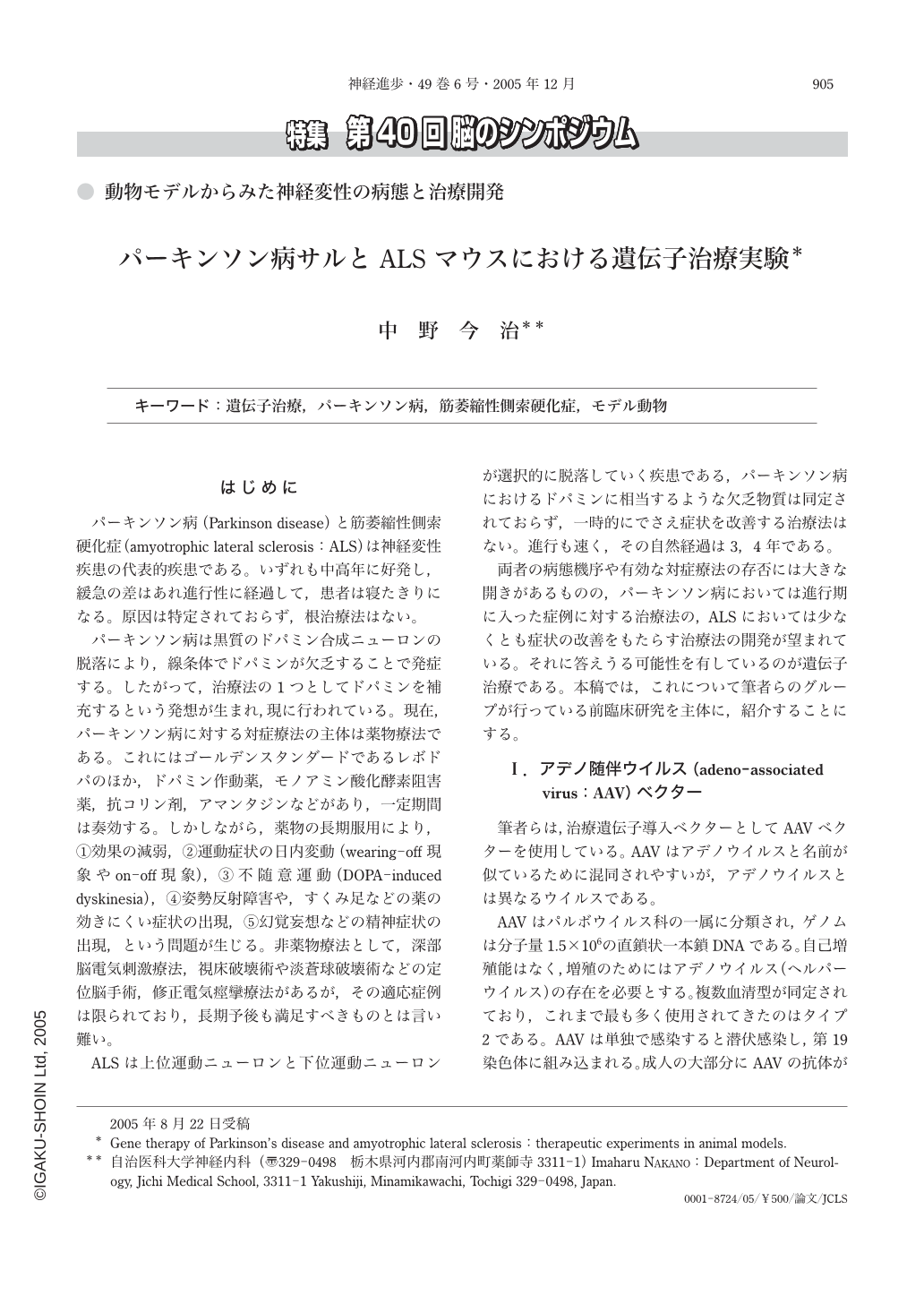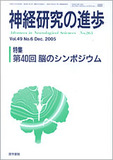Japanese
English
- 有料閲覧
- Abstract 文献概要
- 1ページ目 Look Inside
パーキンソン病(Parkinson disease)と筋萎縮性側索硬化症(amyotrophic lateral sclerosis:ALS)は神経変性疾患の代表的疾患である。いずれも中高年に好発し,緩急の差はあれ進行性に経過して,患者は寝たきりになる。原因は特定されておらず,根治療法はない。
パーキンソン病は黒質のドパミン合成ニューロンの脱落により,線条体でドパミンが欠乏することで発症する。したがって,治療法の1つとしてドパミンを補充するという発想が生まれ,現に行われている。現在,パーキンソン病に対する対症療法の主体は薬物療法である。これにはゴールデンスタンダードであるレボドパのほか,ドパミン作動薬,モノアミン酸化酵素阻害薬,抗コリン剤,アマンタジンなどがあり,一定期間は奏効する。しかしながら,薬物の長期服用により,①効果の減弱,②運動症状の日内変動(wearing-off現象やon-off現象),③不随意運動(DOPA-induced dyskinesia),④姿勢反射障害や,すくみ足などの薬の効きにくい症状の出現,⑤幻覚妄想などの精神症状の出現,という問題が生じる。非薬物療法として,深部脳電気刺激療法,視床破壊術や淡蒼球破壊術などの定位脳手術,修正電気痙攣療法があるが,その適応症例は限られており,長期予後も満足すべきものとは言い難い。
ALSは上位運動ニューロンと下位運動ニューロンが選択的に脱落していく疾患である,パーキンソン病におけるドパミンに相当するような欠乏物質は同定されておらず,一時的にでさえ症状を改善する治療法はない。進行も速く,その自然経過は3,4年である。
両者の病態機序や有効な対症療法の存否には大きな開きがあるものの,パーキンソン病においては進行期に入った症例に対する治療法の,ALSにおいては少なくとも症状の改善をもたらす治療法の開発が望まれている。それに答えうる可能性を有しているのが遺伝子治療である。本稿では,これについて筆者らのグループが行っている前臨床研究を主体に,紹介することにする。
Parkinson's disease(PaD)and amyotrophic lateral sclerosis(ALS)are representatives of neurodegenerative diseases. Although there are medical or neurosurgical treatments for patients with PaD, they finally fall into a bed-ridden state because the therapies are not curative but only symptomatic. Patients with ALS cannot enjoy even such a symptomatic therapy that brings transient amelioration. Thus, development of new and effective therapies against these conditions is earnestly desired.
We use adeno-associated viruses as vectors that are known to be non-pathogenic to human beings, and to transfect non-mitotic cells like neurons and muscle cells.
One of our strategies of PaD gene therapy is to recover dopamine production in the striatum by injecting there genes of enzymes that work in dopamine synthesis:tyrosine hydroxylase(TH), GTP cyclohydrolase I(GCH), and aromatic L-amino acid decarboxylase(AADC). Simultaneous injection of AAV-TH, AAV-GCH, and AAV-AADC into the unilateral putamen of 1-methyl-4-phenyl-1,2,3,6-tetrahydropyridine(MPTP)-produced parkinsonian monkeys clearly improved contralateral limb movements for years. Immunohistochemistry using anti-TH, -GCH, and-AADC antibodies revealed obvious immunoreactivity in the widespread area of the treated putamen respectively. Micordialysis of the putamen of such monkeys demonstrated recovery of dopamine production in the treated side. Based on those data, we are planning to conduct a clinical research of gene therapy of PaD.
Regarding ALS gene therapy experiments, we injected the limb muscles of G93A SOD1 transgenic mice with AAV-GDNF(glial cell-derived neurotrophic factor)with an expectation that GDNF produced in the injected muscles be retrogradely transported to the motoneurons and to protect them by autocrine and/or paracrine. Four limbs injection of AAV-GDNF delayed the onset and prolonged the survival of the mice significantly. Unilateral AAV-GDNF injection ameliorated symptoms as well as rescued anterior horn motoneurons only ipsilaterally.
Thus, gene therapy using AAV vectors can be a promising treatment of tragic neurodegenerative diseases such as PaD and ALS.

Copyright © 2005, Igaku-Shoin Ltd. All rights reserved.


